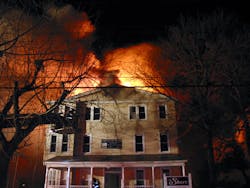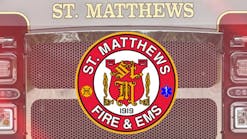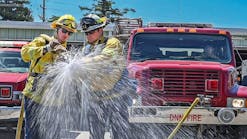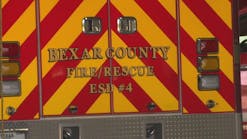The Probationary Firefighter: An Introduction to Incident Command
Firefighters graduating their basic training program are rightfully very proud of their accomplishment. This is just the beginning of an enjoyable and fulfilling experience that must be founded on further training. As enjoyable as a profession as this is, there is still the potential to not return home after a shift or a fire. Far too many after-action reports list the breakdown of the department’s command structure or the lack of such a command structure altogether as root causes for members being killed in action.
In this article we will attempt to instill in the newest firefighters the importance of Incident Command. We will break it down into an easy to understand format. Like every organizational system, it is vital that all of the players know and understand the process and their role in it.
So many excellent sources are available on this topic. We will not attempt to reinvent the wheel, but rather discuss the incident command system (ICS) from the layman’s point of view. Sometimes our newest firefighters are subjected to information overload and will begin to prioritize what they perceive to be important. The large amount of information, concepts, and terminology just at the basic levels (I-100 and I-700) alone might be enough to intimidate the newest member.
Therefore we will cover the very basics and at the end provide a tiered system of further education that a firefighter can pursue at their convenience. It is important that such large amounts of information be digested over a period of time and not all at once.
There are many great sources available that offer free online training, supplemented with large amounts of downloadable information, and provide documentation after successfully completing an online exam.
The Basic Ingredients Of Incident Command
Incident Command has three major principles. If these principles are adhered to, the incident or event will be easier to manage, easier to control, more effective, and much safer for those operating. ICS applies to all of our responses, from the single engine response to a multiple alarm fire. The great thing about ICS is that it is very flexible and can be tailored to the situation.
Principle 1: Every incident or event needs someone to be in charge. In other words, we need an Incident Commander (sometimes called the IC) (see Figure 1).
Principle 2: The IC must be able to look at the incident and break it down into small, manageable, bite-sized pieces each led by someone he or she can trust.
Principle 3: There is a need for staging responding resources.
Let’s take a look at these three principles and see how they can make the fireground a safer and more effective place to operate.
Principle 1: It is critical that someone be in charge. If no one takes the “reigns” we are going to have chaos. Furthermore, the person who steps up to the plate must be proficient in his or her role. At least to the point to recognize the dangers, to recognize that he or she may not have the ability to handle this level of complexity, and the good sense to call for those leaders that do.
Far too many disasters have befallen the fire service due to a lack of training, education, and experience. Failure to be proficient, failure to “know the job” could very possibly lead to disaster even if the basic ICS principles are utilized! Large-scale operations or operations that are out of the ordinary may demand a teamwork approach to management. This is called a Unified Command and is well out of the scope of this article. The sources below go into great depth as it relates to this topic and other complex details.
Principle 2: The IC must be able to look at an incident and say, “I can divide this up into smaller parcels of responsibility.” In other words, the use of Division and Group Supervisors are critical at a larger or evolving incident. The IC will tell each supervisor their part in the overall plan, give them the appropriate resources to accomplish the mission, and then turn them loose (within the parameters of the “Incident Action Plan”). The goal here is to alleviate the IC from becoming a micromanager resulting in him or her becoming completely overwhelmed and loosing sight of the big picture.
For even larger-scale operations, the principle remains the same except that the use of Operations, Logistics, Planning, and Finance/Administration sections are the immediate tier beneath the IC. Nevertheless, the principle of looking at an incident and breaking it down into manageable pieces remains the same. Ultimately, what we are doing is relying on the concept of “division of labor” whereby specific areas of expertise or geographical areas are used. We are seeking to eliminate redundancy and maximize our resources.
This principle also enhances accountability. It is critical that we know who is operating and where. Using this principle, we have a regimented chain of command where a department member reports to a single supervisor who in turn reports to another (and so on). Using ICS effectively demands that each person who has the responsibility for leading personnel not exceed his or her “span of control.” Simply put, this means that each person may oversee anywhere between three and seven people who report to the supervisor (five is the optimum number for most incidents).
For example, an engine or ladder company may have three firefighters reporting to a company officer. At an incident there could be three engines and one ladder company reporting to a Group Supervisor, who in turn perhaps, reports directly to the IC. In this case, the supervisor is dealing with only the four company officers that in turn give direction to the firefighters under their immediate command. This concept is a key element in effective ICS.
Principle 3: The need for staging is another vital component. We must be able to “corral” responding resources. If they don’t have a place to go, if they are not given specific directions, then their company officers may very possibly do what they think is best. In other words … freelancing!
At the majority of incidents that we respond to, where multiple units are engaged in combat, these three principles will help any department to be successful. The key is training, education, and experience on the part of not just the IC, but of all members on the fireground! (see Figure 2).
A Typical Scenario
The scenario is a fire on the third floor of a three-story apartment building. The building is of Class 3 (ordinary construction). It is occupied with two families per floor. The fire originated in an unoccupied bedroom on the top floor. There are attached buildings of similar construction on either side. A common cockloft runs overtop of each of the three occupied buildings and smoke appears to be showing near the roof on the D side. The time is 3 a.m.. It is January and the temperature is 10 degrees and a 20 mph wind is blowing towards the “Delta” exposure. The response is a chief officer, three engine companies and a ladder company each staffed with three firefighters and an officer. A second alarm assignment will bring a similar response as will a third alarm.
Upon arrival, our first-due officer is greeted with many problems. He recognizes the potential life hazard not only to firefighters, but also to civilians inside the fire building and exposures as well as to bystanders and realizes that additional resources will be needed, i.e., a second alarm. Using the principles of ICS that we discussed prior, the incident would unfold in a manner whereby the first-due officer (and eventually his or her supervisor):
1. Establishes Command (the arrival of a supervisor would entail him/her assuming command from the initial IC)
2. Establishes an “Interior” Division Supervisor who is tasked with locating, confining, and extinguishing the fire as well as making sure searches for victims and fire are completed. This could be a company officer initially or a chief officer responding on a greater alarm. The IC allots a given amount of resources to this supervisor and the goals and objectives that he expects this supervisor to complete. This supervisor is also the eyes and ears of the IC and paints a picture for the IC of what is going on inside the building. Reconnaissance and intelligence gathering are critical at all operations, so periodic progress reports are a must!
3. Establishes a “Roof” Division Supervisor – this supervisor is given adequate resources to conduct vent operations and prevent the spread of fire laterally. Like the Interior Division Supervisor, the Roof Division Supervisor gives periodic progress reports to the IC, painting a picture from the view of the roof.
4. Establishes a “Delta” Division Supervisor – tasked with taking charge of resources and preventing extension into the D exposure
5. Establishes a “Bravo” Division Supervisor – tasked with taking charge of resources and preventing extension into the B exposure
6. Establishes a staging area and puts a company officer or other qualified individual in charge as the “Staging Area Manager.” In this evolving incident, additional resources (a second or perhaps a third alarm) will be required for fire attack, search, exposure protection, rotation and relief, and the need to maintain a tactical reserve. Staging offers them a place to go.
Summary
While this scenario is simplistic, it identifies how the fireground can be divided into smaller, bite-sized, and more manageable pieces. Note how the concepts of “span of control” are utilized, as is a chain of command. The ICS is very simple and very flexible to work with. In the above scenario, the roles of operations, logistics, planning, and finance were not used. In lieu, the incident was broken down into divisions who reported directly to the IC.
Our newest firefighters know that their responsibility in this operation is to report to their company officer, who in turn reports to their next level of authority. The end result is a fireground that is less chaotic than if these principles were not utilized.
The principles of ICS are of such great value. ICS should be more than just a mandatory subject that students see once and never are subjected to again until it is too late. It offers flexibility and allows departments to do more with what they have. For our newest members, you must learn these principles of ICS and watch how your leaders incorporate these principles into your responses. You will eventually become the department’s Incident Commander one day and you must understand how vital the concept is (see Figure 3).
Online Resources Through FEMA And The National Fire Academy
From the Emergency Management Institute / FEMA is the course entitled IS-100.a, Introduction to Incident Command System, ICS-100.
From the Emergency Management Institute / FEMA is the follow-on to ICS-100 entitled IS-700.a, NIMS, An Introduction.
From the Emergency Management Institute / FEMA is the next level of ICS that a more seasoned firefighter should pursue entitled IS-200.a, ICS for Single Resources and Initial Action Incidents.
From the National Fire Academy, there are 12 Incident Management courses that are available for any member. Of these 12 online classes, pay particular attention to four of the ICS classes that are forming the hallmark for emergency responders in the United States: ICS-100; ICS-200; ICS-300; ICS-400.
*Note: These courses are great introductions to the various levels of ICS, but many departments may require their students to take a resident program so that the student participates in the interaction and practical activities. Also, the FEMA and National Fire Academy online classes ICS-100 and ICS-200 are very similar in content.
References
- NFPA 1561 - Standard on Emergency Services Incident Management System.
Armand F. Guzzi, Jr. has been a member of the fire service since 1987. He is a career firefighter with the City of Long Branch (NJ) and has taught for more than 20 years with the Monmouth County Fire Academy (NJ). He has a Masters Degree in Management and undergraduate degrees in Fire Science, Education, and Business Administration. View all of Armand's articles here. He can be reached via e-mail at [email protected] or [email protected].

Armand Guzzi | Firehouse.com Contributor
Armand F. Guzzi, Jr. has been a member of the fire service since 1987. He recently retired a career fire lieutenant with the City of Long Branch, NJ, Fire Department and is the deputy director of the Monmouth County, NJ, Fire Academy where he has taught for over 20 years. He has a Master's degree in management and undergraduate degrees in fire science, education, and business administration. View all of Armand's articles here. He can be reached via e-mail at [email protected] or [email protected].






